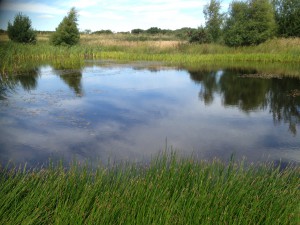
A stormwater pond. Image from The Highland Council
A recent study by Scottish Natural Heritage and The Highland Council has found that sustainable urban drainage systems (SuDS) ponds between Inverness and Nairn in Scotland are supporting a wide variety of wildlife.
Marcia Rae, the council’s graduate research assistant, identified 71 water bodies in the area as part of the investigation. Of these water bodies, Rae visited 12 and assessed seven for water quality using the Open Air Laboratories method, which is designed for a UK-wide citizen science initiative. Five were classed in the “very healthy” category, and two were classed in the “quite healthy” category. The two classified as quite healthy were sites closest to the A96 highway.
Rae found all three common species of amphibians during the course of this work, including frogs, toads, and newts. These findings suggest that there is an existing network of wetland habitat in the area that successfully supports amphibians and other wildlife. With proposed development in the A96 corridor, it is important to ensure that this wetland habitat is preserved or enhanced. New development will have a legal requirement to implement SuDS, providing an opportunity to further support amphibian species. Amphibians are listed as a priority in the Inverness and Nairn Local Biodiversity Action Plan (LBAP).
“SuDS could work to increase the wetland habitat network that is important for so many species and ensure that urban expansion can work with and for wildlife as well as people,” Rae said.
This work builds on research by David O’Brien to establish the wildlife value of Inverness ponds as well as Rae’s own research. Within Inverness, Rae identified 40 sites. Amphibians are using 75% of these sites along with a range of other wildlife. Water quality testing demonstrated that the ponds are of good quality and in some cases very healthy. Nitrates and phosphates were found in the water, which the researchers expected from the urban environment. However, these nutrients were not at high enough levels to affect amphibian populations. Nearly half of the ponds surveyed in Inverness are in excellent condition and the remainder could be brought up to this level with minimal intervention.
Rae presented the findings at the Highlands first SuDS conference. At the event, Catherine Lloyd of the Tayside Biodiversity Partnership also discussed the effects of gully pots on amphibians when migrating to urban ponds. Gully pots are entry points for road runoff into the drainage network. Thousands of amphibians are trapped and killed in roadside drains when they fall into the gully pot and cannot escape. The award-winning “Amphibians in Drains” project has made progress in preventing amphibians from getting caught in drains. Project participants are now installing amphibian ladders in gully pots near ponds to ensure amphibians can escape.



